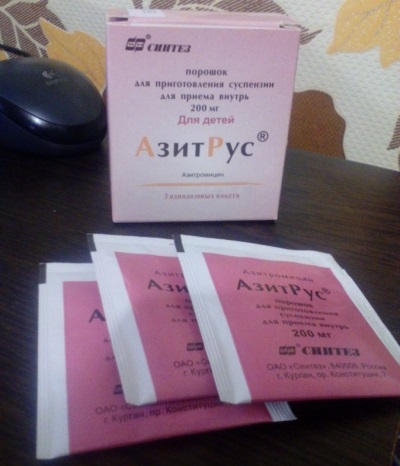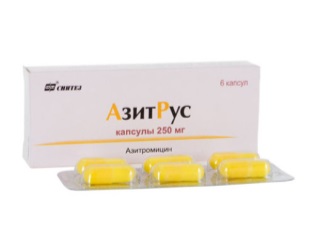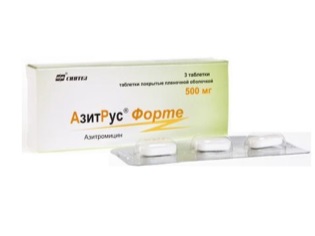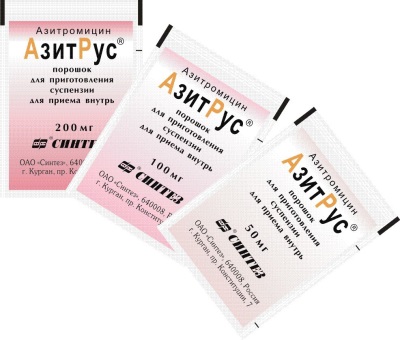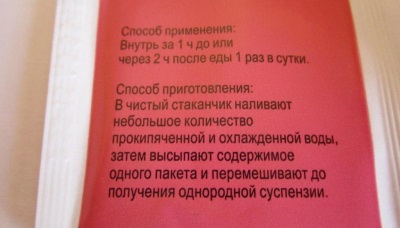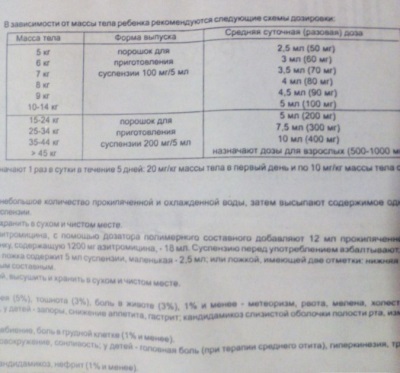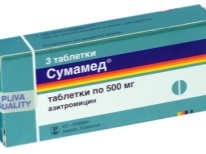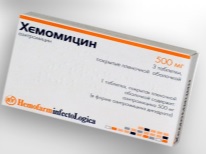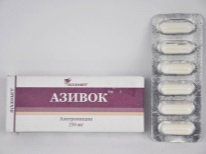AzitRus powder for children: instructions for use
Azithromycin attributed to effective antibiotics that help with pneumonia, otitis, scarlet fever and many other infections. One of the Russian drugs with such active ingredient is AzitRus. When can you give this medicine to children, how is it dispensed and what side effects can it provoke in the children's body?
Release form
A convenient form for use in childhood is the powder from which the suspension is prepared. It is almost a white loose substance with an orange odor. The medicine prepared from such a powder is a homogeneous suspension, which has a white color and a slightly yellowish tint.
For ease of use and storage, the powder is packaged in bags weighing 4.2 grams. In one package there can be 3 or 6 such bags. The manufacturer produces not only packs of bags of pre-packed powder, but also packs, which additionally include a cup.
The medicine is also produced in capsules and coated tablets, called Azithus forte. Such forms of this antibiotic are not used in early childhood.
Composition
Each packet of AzitRus contains 50 mg, 100 mg, or 200 mg of the active substance, represented by the macrolide antibiotic azithromycin. The sweetness of the prepared powder suspensions provide sucrose and saccharinate sodium, and a pleasant smell - the presence in the composition of orange flavoring. Also in the powder AzitRus there are auxiliary compounds such as crospovidone and sodium citrate.
Operating principle
Azithromycin has a bacteriostatic effect on many types of bacteria, inhibiting protein synthesis, growth and reproduction processes. If the concentration of the drug is high, the effect will be bactericidal. The drug effectively affects the pathogens that are inside the affected cells. The drug is active against streptococci, hemophilus bacilli, staphylococci, bordetella, chlamydia, clostridia, mycoplasma and many other pathogens.
When the child has taken AzitRus, its active substance is rapidly absorbed in the gastrointestinal tract, after which it is transferred throughout the body with the blood flow. Since azithromycin does not bind to proteins, the drug quickly leaves the bloodstream, penetrating infected tissues.
After taking the last dose, the concentration of the antibiotic remains high at the site of inflammation for another 5-7 days, so that the courses of treatment with AzitRus are short.
For information on when to give your child antibiotics, see Dr. Komarovsky’s program.
Indications
Use AzitRus in the treatment of children should be in inflammatory and infectious diseases caused by bacteria that are sensitive to azithromycin.
An antibiotic may be prescribed:
- Children with angina, pharyngitis, otitis media, sinusitis and other lesions of the upper respiratory tract.
- If the child is diagnosed with scarlet fever.
- With bacterial pneumonia or bronchitis.
- If bacteria provoke infection of soft tissues or skin, for example, furunculosis or erysipelas.
- In urethritis, provoked by bacterial flora.
- A child with borreliosis in the early stages of the disease.
- As a drug of combined treatment for gastrointestinal diseases caused by Helicobacter.
At what age is it allowed to take?
Suspension from AzitRus powder form is prescribed to children who have already turned 6 months. Dosage is calculated by weight of the child.
Age norms of other forms of release:
- AzitRus capsules can be given to children over three years old or with a child weighing more than 25 kg.
- The tablet form (AzitRus Forte) is intended for children weighing more than 50 kg or over the age of 12 years.
Contraindications
Treatment with AzitRus is not prescribed for:
- Renal failure.
- Hypersensitivity to macrolides.
- Hepatic insufficiency.
- Aged less than 6 months.
If an arrhythmia is detected in the child, prescription of the medicine requires caution.
Side effects
A child’s body can react to AzitRus with negative symptoms from the digestive tract:
- The dilution of the chair.
- The emergence of nausea.
- Abdominal pains.
- Meteorism.
- With the onset of vomiting.
- Jaundice
- Blacking feces.
- Constipation.
- Reduced appetite.
- Changes in taste.
Less commonly, the drug provokes such side effects as:
- Development of candidal stomatitis.
- The appearance of gastritis.
- Chest pain and palpitations.
- Drowsiness, headaches, increased anxiety and sleep problems.
- Kidney damage.
- Allergic reactions, such as hives, itchy rash, or allergic conjunctivitis.
- Enhanced sensitivity to light.
- Asthenic state.
- Candidiasis of the mucous genitals.
Instructions for use and dosage
To make a suspension, you need to take boiled cooled water into a clean glass, then open the bag with AzitRus powder and pour its contents into the glass. When mixing means a homogeneous white liquid. The medicine in the right dose is given to the baby, after which the glass is washed under water and dried. In milk, dilute the drug can not.
The frequency of application AzitRusa - once a day. The drug should not be mixed with food, so the instructions for use clarify that you can drink the suspension either an hour before a meal, or about 2 hours after a meal. If the medication is missed, you need to drink the drug immediately, as it is detected, and then the following doses are given to the child with a pause of 24 hours.
The dose of antibiotic for infections of the respiratory organs, soft tissues or skin is 10 mg of azithromycin per kilogram of baby weight. If the treatment lasts 3 days, then the course dosage will be 30 mg per 1 kg of body weight of the child. If the drug is prescribed for 5 days, then on the first day of administration, for each kg of the crumbs weight, 10 mg of the active substance is given, and on subsequent days, from 5 to 10 mg.
For children who weigh less than 15 kg, use sachets of 100 mg azithromycin. One such package must be diluted in 5 ml of water. With a weight of 5 kg, the baby is given 1 intake of 50 mg of the drug, which is 2.5 ml of the suspension. For each kilogram of weight add 10 mg of active substance or 0.5 ml of the prepared suspension, for example, babies weighing 6 kg require 60 mg of medication, which corresponds to 3 ml of suspension.
For children weighing from 10 to 15 kg, a single dosage of the drug is 100 mg (5 ml of suspension). With a weight of more than 15 kg bags are used, in which azithromycin is contained in a dosage of 200 mg.
The drug is also diluted in 5 ml of water and given in such a daily dose:
|
The weight of the child is from 15 to 24 kg |
5 ml suspension (200 mg azithromycin) |
|
The weight of the child is from 25 to 34 kg |
7.5 ml suspension (300 mg of active substance) |
|
The weight of the child is from 35 to 44 kg |
10 ml suspension (400 mg of active ingredient) |
If the child weighs more than 45 kg, the medicine is prescribed in an adult dosage - from 500 to 1000 mg per day.
If AzitRus is prescribed for borreliosis, then on the first day of treatment the child is given 20 mg of active substance per day for each kilogram of his weight, then the dosage is reduced to 10 mg / kg - this is the amount given on the second to fifth day of therapy.
Overdose
If you give your child AzitRus in excess dose, it can lead to nausea, vomiting, diarrhea, or temporary hearing loss. In such a situation, gastric lavage is indicated. If required, the baby is also prescribed symptomatic treatment.
Interaction with other drugs
- It is impossible to combine AzitRus and antacid agents with magnesium or aluminum content. There must be at least 2 hours between taking such drugs, otherwise the absorption of azithromycin will be disturbed, which will affect the effectiveness of the treatment.
- Since, under the influence of azithromycin, the work of hepatocytes is complicated, with this antibiotic do not combine indirect anticoagulants, cycloserine, xanthine derivatives, methylprednisolone, bromocriptine, and some other drugs. Neutralization in the liver will be slow, which will lead to toxic effects on the children's body.
- If the child being treated with AzitRus is prescribed warfarin, control of protrobin time is required.
- If the baby is given Digoxin, then combined use with AzitRus will increase the concentration of such glycoside in the blood.
- Ergotamine or Dihydroergotamine in the appointment of AzitRus will have a more pronounced toxic effect.
- Triazolam, assigned with AzitRus, will enhance its therapeutic effect.
- If your child is given linkosamines, azithromycin treatment will be less effective, with the additional prescription of chloramphenicol or tetracycline, on the contrary, the efficiency of AzitRus will increase.
Look at the transfer of Dr. Komarovsky, from which you will know when to take antibiotics, and when their reception will harm the crumbs.
Terms of sale
Buying AzitRus in pharmacies requires a prescription from the doctor. The average price of a package with 3 sachets of medication 100 mg is 35 rubles.
Storage conditions and shelf life
Keep packaging with AzitRus should be in a dry place, where there is no high humidity, and the temperature is not higher than + 25 ° C. It is important to ensure that young children do not have access to AzitRus during storage. The shelf life of the drug from the date of issue is two years.
Reviews
Moms speak about this drug mostly well. They note that the effect after the application of Azitrus comes quickly enough and the child soon recovers. In many babies, the temperature decreases after just one dose of the drug, which improves their well-being.
One of the main advantages of drugs called ease of use. Most mothers like the product to be a powder, packaged in portions, easily stirred and given to a child only once a day, and the course of treatment is short. In addition, an additional advantage is the low cost.
However, like other antibiotics, AzitRus can provoke side reactions. Mothers most often report nausea or diarrhea. Other side effects are quite rare.
Analogs
If it is not possible to give the child AzitRus, the medicine can be replaced with another antibacterial agent with the same active ingredient, for example, to use:
- Sumamed. This antibiotic is released in powder (given to children older than 6 months), 125 mg tablets (prescribed from 3 years of age), as well as 500 mg capsules and tablets (allowed from 12 years of age).
- Hemomycin. Such medicine in the form of a powder is allowed from 6 months of age, and in tablets from 12 years.
- Azivok or Zitrolid. Such azithromycin capsules are indicated for the treatment of children over 12 years of age.

